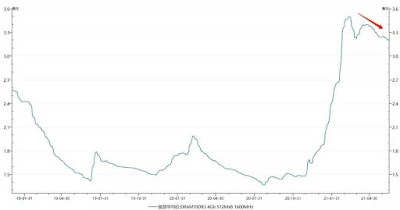Bitcoin, which stabilized briefly after the plunge, fell sharply again. At about 20:30 on June 22, Beijing time, Bitcoin eventually fell below the $30,000 mark.
According to data from Bitcoin quotation website Coindesk, at 20:27 pm on the 22nd, Bitcoin dropped sharply to 29,771 U.S. dollars. The cumulative decline in the past 24 hours reached 9.12%, and it fell to 2,976 U.S. dollars in one day. At this time, $64,829, the highest point in Bitcoin history in April, has been cut below the waist.
Reuters reported on the 22nd that there was a "death cross" on the technical side of Bitcoin. For Bitcoin, the key is whether it can hold the low of $30066 reached on May 19, which is the initial goal of the bears. A break below this level will strengthen the negative signal of a "death cross".
What has caused the market to pay great attention is the recent continuous efforts of Chinese regulators to strengthen the supervision of Bitcoin, and Bitcoin has also fallen continuously.
On June 21, the People’s Bank of China issued a document stating that it has interviewed some banks such as Industrial and Commercial Bank of China, Agricultural Bank of China, Construction Bank, Postal Savings Bank, Industrial Bank and Alipay on the issue of providing services for virtual currency transactions by banks and payment institutions. And payment institutions. The People's Bank of China pointed out that virtual currency trading activities disrupt the normal economic and financial order, breed the risks of illegal cross-border transfer of assets, money laundering and other illegal and criminal activities, and seriously infringe the people's property safety. Banks and payment institutions shall not provide products or services such as account opening, registration, trading, clearing, and settlement for related activities. Institutions must comprehensively investigate and identify virtual currency exchanges and over-the-counter dealers' capital accounts, and cut off the transaction funds payment link in a timely manner.
As soon as the news came out, six institutions issued announcements and stated that they strictly prohibit any institution or individual from using institutional services to conduct virtual currency transactions, and resolutely refrain from conducting or participating in any virtual currency-related business activities. Encrypted currencies in the global market have heard a collective dive.
China has always made it clear that Bitcoin does not have the "legal status" of currency. Previously, it has clearly forbidden the establishment of Internet platforms to provide transactions for Bitcoin and other virtual currencies, and the exchange between virtual currencies and digital currencies is also prohibited.
On December 5, 2013, the People’s Bank of China and other five departments jointly issued the "Notice on Preventing Bitcoin Risks", stating that Bitcoin is not issued by the monetary authority, and it has no monetary properties such as legal compensation and compulsion, which is not true. Currency. The "Notice" prohibits financial institutions and payment institutions from conducting bitcoin-related businesses and reminds individuals to guard against risks, but it does not expressly prohibit individuals from participating. In 2017, the Central Bank and other 7 departments issued the "Announcement on Preventing the Risk of Token Issuance Financing", prohibiting the establishment of virtual currency trading platforms in China and prohibiting the exchange between virtual currency and legal currency. Subsequently, large-scale virtual currency trading platforms in China have been shut down.
Recently, the Chinese authorities have continued to tighten the supervision of cryptocurrencies such as Bitcoin. On May 21, the Financial Stability and Development Committee of the State Council held its 51st meeting and proposed to crack down on Bitcoin mining and trading activities and resolutely prevent the transmission of individual risks to the social field. Since then, Inner Mongolia, Qinghai, Xinjiang, Yunnan and other places have successively introduced measures to combat and punish virtual currency "mining" behavior. On June 20, it was reported that all bitcoin mines in Sichuan were collectively cut off at midnight that day, and bitcoin miners suffered huge losses as a result. The industry believes that the withdrawal of all domestic bitcoin mines is a foregone conclusion.
At the same time, Bitcoin has started this round of vigorous decline in the market, and finally fell below the $30,000 mark on the evening of June 22.
The legitimacy of Bitcoin's identity has always been suspected by global financial official decision-makers, who believe that it has caused chaos to the existing international financial order. The most important thing to ignore is the attitude of the new US Treasury Secretary Yellen, who has always held a negative attitude towards Bitcoin. On January 25, Yellen’s appointment was considered bad news, causing cryptocurrencies to plunge across the board that day, and Bitcoin dropped more than 10% at its lowest point in the day. Prior to January 19, Yellen stated that the United States should be aware of emerging tools for terrorist financing, and that cryptocurrencies have the opportunity to be misused by illegal financing. The government will need to review the ways in which their use can be restricted and ensure that they will not be carried out through these channels. Money laundering activities. Yellen's statement made Bitcoin fall for three consecutive days. And another international financial policy decision-making figure, former President of the European Central Bank Draghi, also has an unfriended attitude towards Bitcoin. Almost at the same time as Yellen, he also stated that Bitcoin is a highly speculative asset that involves money laundering activities, and a regulatory consensus on Bitcoin needs to be reached at the global level.






